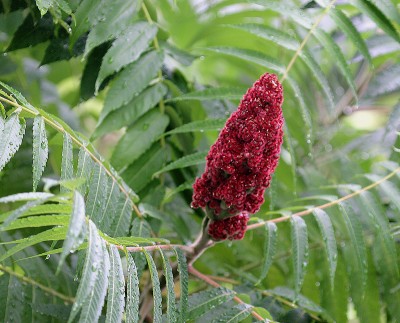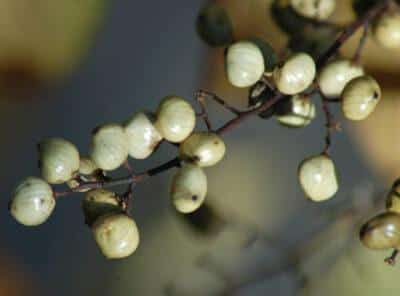Sumac is a fairly common plant, and you were probably taught for years that it is poisonous and should be avoided.
Now, however, we are getting back to discovering the truth behind this plant. Yes, some varieties are poisonous, but many are not, and it’s not difficult to distinguish them.
Not only is it organic and healthy, but we can forage certain varieties for snacks, meals, drinks and spices. High-end restaurants are gathering and using sumac in their dishes. If you are interested in foraging sumac, but have never done so, there are a few things to know.
First, it is not a great idea to forage for sumac along roads or highways, even though the bushes are often full of fruit. This sumac will have absorbed pollution from being so close to the road.
About Sumac
There are 250 geniuses of Sumac. Sumac can be a small tree or a shrub in shape, and likes to grow on dry slopes. It can grow anywhere from four to 35 feet in size. The leaves are notched and grow in slightly taggered pairs until the end, where one leaf will be perpendicular to the rest. Sumac has upright fruit clusters, usually red and covered in a velvet fuzz. Sumac clusters are called drupes. The berries ripen in summer and tend to be wet and sticky when ripe. The taste is said to be sour and much like lemon.
Sumac grows all over the world, in North America, Europe, Middle East and the Mediterranean. It has been used for medicinal purposes, made into spices and often used as an ingredient in flavoring. Sumac is often put into Za-atar as an ingredient. Za-atar combines sumac and other spices and herbs. It can be used as a rub or seasoning on meat, fish or salad and used on kebabs. Desserts and drinks also can be dressed with sumac as a syrup.
The Hidden Secrets Of Making Herbal Medicines…Right At Your Fingertips!
Sumac is high in vitamins A and C, as well as being full of antioxidants.
Edible Varieties of Sumac
- Staghorn Sumac, Rhus Typhina
- European Sumac, Rhus Coriaria
- Smooth Sumac, Rhus Glabra
- Fragrant Sumac, Rhus Aromatica
- Desert or little leaf Sumac, Rhus Microphyllia
- Lemonade Sumac, Rhus Integrifolia
- Sugar Sumac, Rhus Ovata
- Dwarf Sumac, Rhus Copallina
Most types of sumac have fuzzy fruit except the Smooth sumac, hence the name.
Harvesting Sumac
To harvest sumac, locate the desirable clusters that are the brightest color on the tree or bush. Touch the fruit to check for a slightly sticky feel. You can even lick your fingers to see if it has the tart taste. Clip at the base of the cluster early in the season with some sort of pruning shears. By doing this early in the season, there is less chance of mold or insects. Keep in mind: You only need the clusters.
Remember!
Poison sumac – which grows in the Eastern US — has white or gray berries, where edible sumac has red, brown, purple or maroon fruit. Also, people can be allergic to sumac, just like everything else. You need to be aware of this when you eat sumac for the first time.
Poison Ivy, poison oak and poison sumac are all related to the edible kind of sumac, but all look different. Know what you are looking for, before foraging. Consult an expert before foraging if you are not experienced or trying a new plant.
Recipes
To prepare edible sumac, you can dip the clusters in water (room-temperature) right after harvesting.
New “Survival Herb Bank” Gives You Access to God’s Amazing Medicine Chest
Leave them overnight, or until the water turns red.
For Spice
Recipe One
-
Lay sumac out on newspaper, with lots of air flow.
- Move or stir sumac at least once a day.
- Once dry, remove the leaves and sticks.
- Place in food processor.
- Process for a few minutes, leaving just the seeds.
- Place into a strainer and sift. You also can grind in a coffee grinder.
- You can roast the seeds to eat or make a dye.
Recipe Two
- Dry clusters under heat lamps or in an oven at 125-150 degrees Fahrenheit. You also can use a dehydrator.
- When dry, break up the clusters.
- Place in blender.
- Push through a medium-mesh strainer to separate any remaining sticks and seeds.
Spice will last over a year when stored in a cool, dry place.
For Concentrate or Drinks
- Soak five to eight clusters in eight cups of room-temperature water, for a few hours.
- Crush clusters by hand.
- Do not use boiling water or hot water as it will change the acidity of the berries.
- Drain with cheesecloth or a coffee filter to remove any debris.
- Add honey or sugar to taste
So foragers, with this knowledge of sumac, grab your pruners and enjoy the harvest. Experience sumac’s citrus taste in a variety of fresh and cooked dishes. Whether you are new to foraging or an experienced pro, you are bound to have an adventure foraging for sumac.
Do you have any tips for foraging sumac? Share them in the section below:
Harness The Power Of Nature’s Most Remarkable Healer: Vinegar. Read More Here.
 Off The Grid News Better Ideas For Off The Grid Living
Off The Grid News Better Ideas For Off The Grid Living





